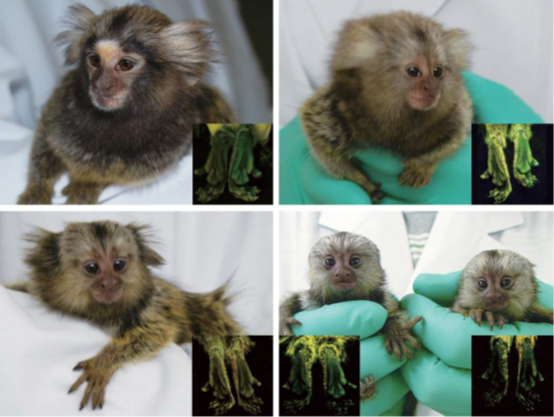Research Highlights
Vol.1, August 2014
Transgenics – gene manipulation enters the next generation
Transgene expression was observed
in founder marmosets and their offsprings
Transgenics could provide treatments for genetic diseases by introducing genes that modify an organism’s characteristics. Researchers have now demonstrated transgene expression in marmosets - a non-human primate - as well as a transgenic marmoset’s offspring. The technique, as the researchers conclude in their report on the work, “may provide the means to obtain genetically modified non-human primate models for translational research, investigations of regenerative medicine and gene therapy, and clarification of the scientific gaps among transgenic mice, human disease models, and real human diseases.”
A transgene approach to knockout a cystic fibrosis gene in swine has already been demonstrated. Marmosets are genetically closer to humans than swine, and they also reach sexual maturation quickly and reproduce prolifically, which is useful for the development of transgenic technologies. However, previous efforts failed to achieve transgene expression in the cells of marmoset infants.
Researchers at the Central Institute for Experimental Animals (in Kawasaki, Japan) and colleagues developed viruses carrying an enhanced green fluorescent protein transgene, which allowed transgene expression to be determined relatively non-invasively in living embryos and animals. They injected embryos at very early stages of development and transferred the embryos that showed positive transgene expression into marmoset surrogates. Putting the cells in sucrose solution, which enlarges the space where the virus is injected, meant they could inject more of the transgene.
Five of the embryos survived to birth. Of those four showed gene expression in the hair, blood and skin cells. In addition transgene expression was also observed in the reproductive cells of one of the offspring on reaching maturity, who successfully fathered transgenic offspring, demonstrating ‘germline transmission’ of the transgene into the next generation.
Publication and Affiliation
Erika Sasaki1*, Hiroshi Suemizu1, Akiko Shimada1, Kisaburo Hanazawa2, Ryo Oiwa1, Michiko Kamioka1, Ikuo Tomioka1,3, Yusuke Sotomaru5, Reiko Hirakawa1,3, Tomoo Eto1, Seiji Shiozawa1,4, Takuji Maeda1,4, Mamoru Ito1, Ryoji Ito1, Chika Kito1, Chie Yagihashi1, Kenji Kawai1, Hiroyuki Miyoshi6, Yoshikuni Tanioka1, Norikazu Tamaoki1, Sonoko Habu7, Hideyuki Okano4* and Tatsuji Nomura1 Generation of Transgenic Non-Human Primates with Germline Transmission. Nature, 459, 523-528, (2009).
- Central Institute for Experimental Animals, 1430 Nogawa, Miyamae-ku, Kawasaki, Kanagawa 216-0001, Japan
- Department of Urology, Juntendo University Nerima Hospital 3-1-10 Takanodai, Nerima-ku, Tokyo 177-8521, Japan
- Center for Integrated Medical Research, Keio University School of Medicine, 35 Shinanomachi, Shinjukuku, Tokyo 160-8582, Japan
- Department of Physiology, Keio University School of Medicine, 35 Shinanomachi, Shinjukuku, Tokyo 160-8582, Japan
- Natural Science Centre for Basic Research and Development, Hiroshima University 1-2-3, Kasumi, Minami-ku, Hiroshima 734-8551, Japan
- Subteam for Manipulation of Cell Fate, RIKEN BioResource Centre, 3-1-1 Koyadai, Tsukuba, Ibaraki 305-0074, Japan
- Department of Immunology, Tokai University School of Medicine, Bohseidai,Isehara, Kanagawa 259-1193, Japan
*corresponding authors, e-mail addresses: esasaki@ciea.or.jp or hidokano@sc.itc.keio.ac.jp
Figure:







